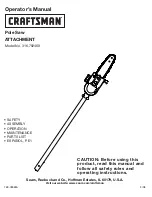
4-1/2" CompaCt CiRCulaR Saw
eNG
10
degrees is marked with a notch on the front of the base
plate (12).
The base plate (12) must always be held firmly against
the material being cut to reduce saw vibration, blade
jumping, or blade breakage.
6. SawDuSt Removal (See Fig. D)
your saw includes a vacuum adapter (10) that attaches to
the dust extraction outlet (9) on the saw. This adapter port
can be attached to a vacuum cleaner (sold separately). The
use of the vacuum is strongly recommended as it keeps
the work area clean, dramatically increases cut visibility
and reduces airborne dust. it also keeps dust out of the
working elements of the guard.
woRKiNG HiNtS FoR YouR tool
if your power tool becomes too hot, please run your
circular saw no load for 2-3 minutes to cool the motor.
avoid prolonged usage at very low speeds.
Protect saw blades against impact and shock. Cutting with
extreme force can significantly reduces the performance
capability of the tool and reduces the service life of the
saw blade. Sawing performance and cutting quality
depend essentially on the condition and the tooth count of
the saw blade. Therefore, use only sharp saw blades that
are suited for the material being cut.
Choice of blades: 24 teeth for general work, approx. 40
teeth for finer cuts, more than 40 teeth for very fine cuts
into delicate surfaces, diamond for tile, cement board, etc.
1. maKiNG CRoSS CutS aND Rip CutS
waRNiNG:
To avoid sudden kick-back, never start
with the stationary blade in contact with the work.
always start the saw and allow it to reach full speed
before plunging into work material.
a) aLWayS use your saw with your hands positioned
correctly.
waRNiNG:
always maintain proper control of the
saw to make sawing safer and easier. Loss of
control of the saw could cause an accident resulting in
possible serious injury.
b) When making cross or rip cuts, align your line of cut
with the center of the “V” notch located on the front
of the saw’s base.
c) Since the thickness of blades varies, make a trial cut
in scrap material along the guideline to determine
how much, if any, you should offset the blade from
the guideline to allow for the blade thickness to get
an accurate cut.
maKiNG Rip CutS
always use a guide when making long rip cuts with your
saw. you can use any suitable straight edge clamped to
the work or the parallel guide that is included with your
saw.
2. poCKet CuttiNG (SoFt mateRialS oNlY)
This operation requires much skill with a saw and must
only be carried out by a qualified person.
waRNiNG:
The blade teeth are exposed during
this operation so proceed with extreme caution.
Clearly mark the area to be cut. Set the depth of cut on
the saw. Position the saw over the marked area with the
front edge of the base plate resting on the work surface
and cutting guide aligned with marked line on workpiece.
Ensure the blade is not touching but is close to the work
surface. The moving lower guard must be rotated open by
using lever. Switch the saw on and gently swing the blade
down into the material but maintain a pivoting force on the
front edge of the base. The moving lower guard can now
be released for normal action of the guard.
Do Not
bind the blade in the cut; push the saw blade
forward at a rate where the blade is not laboring.
When the cut is complete, release the trigger safety
release and switch and let the blade come to a complete
stop.
Do Not Remove
the saw and blade from the
workpiece while the blade is moving. This could damage
your cut (kerf), cause kickback and loss of control,
resulting in injury.
maiNtaiN toolS witH CaRe
Remove the plug from the socket before carrying
out any adjustment, servicing or maintenance.
Keep tools sharp and clean for better and safer
performance. follow instructions for lubricating and
changing accessories. inspect tool cords periodically
and if damaged, have repaired by authorized service
facility. your power tool requires no additional lubrication
or maintenance. There are no user serviceable parts in
your power tool. Never use water or chemical cleaners
to clean your power tool. Wipe clean with a dry cloth.
always store your power tool in a dry place. Keep the
motor ventilation slots clean. Keep all working controls
free of dust.
if the supply cord is damaged, it must be replaced by
the manufacturer, its service agent or similarly qualified
persons in order to avoid a hazard.
Periodically clear dust and chips from guard and base to
ensure proper performance.





























